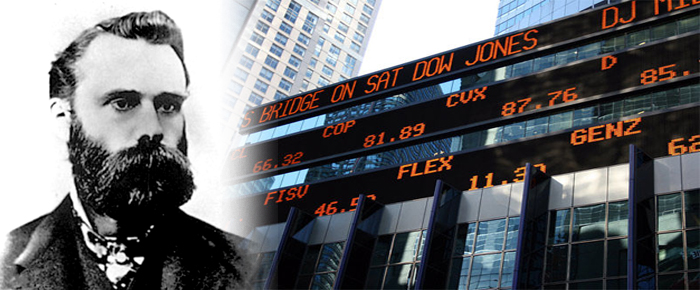
By Haddon Libby
Every day as part of nearly every newscast on radio or television, we are updated as to whether “the Dow” is up or down by some number of points. At present, the Dow is at an all-time high.
This stock market index, the Dow Jones Industrial Average, has been published for nearly 130 years and is probably the most widely followed stock index in the world. Comprised of thirty of the most important publicly traded stocks, the index is the creation of American journalist Charles Dow. With fellow journalist Edward Jones, they started financial news agency, Dow Jones & Company in 1882 in the basement of a candy store. With an early circulation of 1,000 subscribers, Dow and Jones started a two-page Customers’ Afternoon Letter which would become the Wall Street Journal seven years later. Dow and Jones differed from many financial reporters of that era in that they would not take bribes to pump a stock. Their newsletter laid out trustworthy information on the companies that they reported on in an easy to read manner.
The Dow Jones Industrial Average came into being in 1885 as a recession was ending and large corporations (mainly railroads) were looking for investors who would fund the consolidation of their industries. Those companies needed the dissemination of trustworthy, reliable information to help in developing confidence amongst potential investors who were hesitant to invest given the lack of reliable information in the market. Seeing this as an opportunity for their newsletter, Charles Dow devised the first Dow Jones Industrial Average based on the companies that their newsletter followed. To create the average, Dow added together the stock prices of the companies that they followed divided by that number of companies. This index was meant to capture the industrial output of some of America’s top companies.
Starting with a level of 40 points back in 1885, it was not until 1906 that the Dow broke the 100 point threshold for the first time. Following the stock market crash of 1929, it took the index twenty-five years for the index to reach the 381 point mark again. It took another twenty-eight years to pass the 1,000 mark. Over the next twenty-eight years, the index rose to 10,000. It took another fifteen years for the Dow Jones Industrial Average to reach its current all-time high level at just under 18,000.
Since inception, there have been fifty-three changes to the Dow. Approximately 120 companies have been part of the index at some time. It was not until October, 1928 that the Dow consisted of thirty stocks. Some of the stocks included in the 1928 index included American Can, American Sugar, numerous automakers and better known names such as General Electric, Standard Oil (now ExxonMobil) Victor Talking Machine (now RCA) and Woolworth.
Since 2003, there have been eight changes to the Dow. Some of the companies removed from the Dow over that period include Eastman Kodak, Goodyear, Hewlett-Packard and Sears. The current roster of companies include: Cisco, Goldman Sachs, Home Depot, Microsoft, Nike and Visa. Collectively, the thirty companies of the Dow have a market capitalization in excess of $5 trillion.
Where Charles Dow used to do a simple weighting of the stocks in his index where each stock had an equal importance, the current methodology is price-weighted meaning that ten companies of the Dow represent more than 50% of the index.
Only 19% of the current Dow Jones Industrial Average consists of industrials. Financials make up 25% of the index with consumer services (14%), health care (11%) and technology (10%) representing the largest business segments.













































